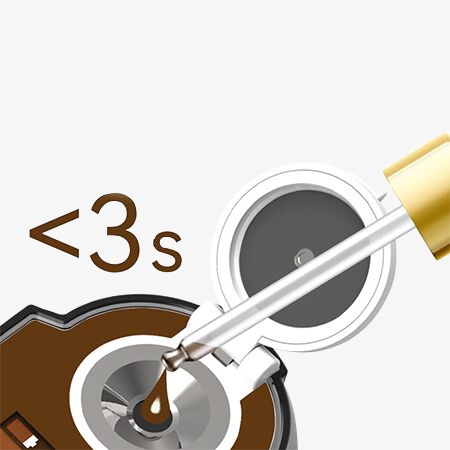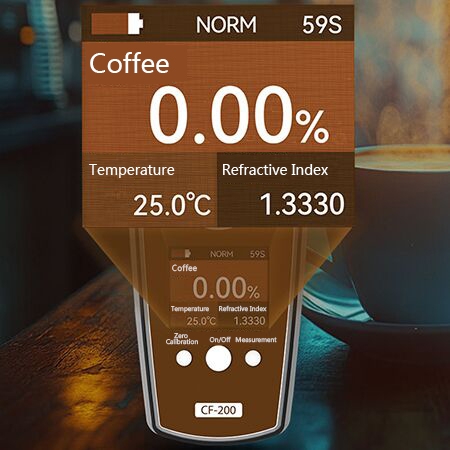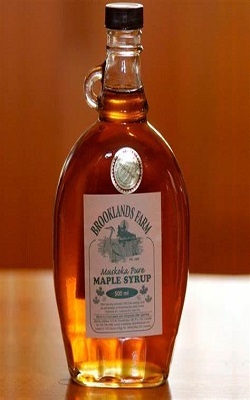Buy a chigh quality handheld coffee refractometer from SISCO. Just turn on the coffee tester, drop a few drops of coffee into the metal sample trough, press the READ button and wait 3 seconds for the result. This coffee concentration meter is suitable for both home use and coffee shops.

Large Display, Results in 3 Seconds
- Large LCD Display: Features a clear, easy-to-read digital screen that shows Brix and TDS values instantly, ideal for quick brew analysis.
Fast 3-Second Measurement: Delivers accurate results in just 3 seconds, saving time during busy coffee preparation or quality control sessions.
High Precision Sensor: Advanced optical technology ensures reliable readings even with small sample volumes.
One-Button Operation: Simple interface allows effortless testing — place a drop of coffee, press the button, and get instant results.
Compact and Portable Design: Lightweight and easy to carry, perfect for cafés, roasteries, and on-site coffee testing.

High-Definition Color Screen for Clearer Readings
- High-Definition Color Display: Equipped with a vibrant color LCD screen that clearly shows Brix and TDS readings, making data easier to read in any lighting condition.
- Enhanced Visual Clarity: The bright, high-contrast interface allows quick interpretation of results, reducing reading errors during busy brewing sessions.
- User-Friendly Interface: Intuitive digital layout with color indicators helps users instantly identify measurement ranges and accuracy levels.
- Real-Time Data Display: Instantly view measurement results on screen with clear, color-coded information for professional brewing analysis.
Applications
SISCO brix refractometers are often used in food and beverage industry, flavor and fragrance industry. The brix refractometer can measure the brix or concentration or salinity of raw materials or semi-finished products and finished products, or online detection of concentration in the production process. Test samples such as cola, fruit juice, tea drinks and other sugar-sweetened beverages, jam, honey, sugar, syrup and other sugar-sweetened foods, condiments, sauces or soups, soy milk, vegetable protein, etc.

Maple Syrup

Beer

Wine

Fruits
| Model | SISCO-RM-CF200 |
| Sugar Content Range | 0-25% |
| Refractive Index Range | 1.333-1.42 |
| Resolution | Concentration 0.01%; Refractive Index 0.0001 |
| Accuracy | Concentration ±0.15%; Refractive Index ±0.0003 |
| Storage Temperature | 0-40°C |
| Measurement Temperature | 10-40°C |
| Dimensions | 121*58*35mm |
| Weight | 130g |
Q1: What is a refractometer?
A1: A refractometer is a scientific instrument used to measure the refractive index of a substance. The refractive index is a measure of how much the speed of light changes when passing through a substance. Refractometers are commonly used in various industries such as food and beverage, pharmaceutical, chemical, and automotive industries, to name a few.
Refractometers work by shining a beam of light through a sample and measuring the angle at which the light is bent or refracted as it passes through the substance. This angle is then compared to a known scale or reference chart to determine the refractive index of the substance. Refractometers can be used to measure a variety of substances such as liquids, gases, and solids, and are particularly useful for measuring the concentration of dissolved solids in a liquid sample, such as sugar content in fruit juice or wine.
Q2: How does a refractometer work?
A2: A refractometer works by measuring the extent to which a beam of light is refracted, or bent, as it passes through a sample. The amount of refraction depends on the refractive index of the sample, which is a measure of how much the speed of light changes when passing through the substance.
The basic design of a refractometer typically consists of a light source, a prism, a sample plate or well, and a detector. The prism is made of a material with a known refractive index, such as glass or plastic, and is designed to refract the incoming light beam at a specific angle. The sample is placed on the sample plate or well, and the refracted light passes through the sample before reaching the detector.
The detector measures the angle of the refracted light and compares it to a known scale or reference chart to determine the refractive index of the sample. This can be done manually by reading the scale or chart, or digitally through a display screen or computer software.
Different types of refractometers may use different methods for measuring the angle of the refracted light, such as through a handheld device, a benchtop instrument, or an inline sensor. Some refractometers also incorporate temperature compensation to account for the effect of temperature on the refractive index of the sample. Overall, refractometers are versatile instruments that can be used to measure a wide range of samples in various industries, from food and beverage to pharmaceuticals and beyond.
Q3: Why do you need a refractometer?
A3: A refractometer is a valuable tool in many industries and applications because it allows for quick, accurate, and non-destructive measurements of the refractive index of a sample. There are several reasons why you might need a refractometer, including:
- Measuring dissolved solids: Refractometers are commonly used to measure the concentration of dissolved solids in a liquid sample, such as sugar content in fruit juice or wine. This can be useful in industries such as food and beverage, where the quality and consistency of products depend on accurate measurements of ingredients.
- Quality control: Refractometers can be used as a quality control tool to ensure that products meet certain specifications or standards. For example, in the pharmaceutical industry, refractometers can be used to check the purity and consistency of drugs.
- Research and development: Refractometers are often used in research and development to study the physical and chemical properties of substances. They can be used to investigate the refractive index of new materials, determine the composition of unknown substances, and to study the effects of temperature and pressure on the refractive index.
- Process monitoring: Refractometers can be used as inline sensors to monitor processes and ensure that they are running smoothly. For example, in the chemical industry, refractometers can be used to monitor the concentration of solutions in real time, helping to optimize production processes and reduce waste.
Tips: What does a digital coffee refractometer measure?
A digital coffee refractometer measures the total dissolved solids (TDS) and Brix in brewed coffee, espresso, or other coffee beverages. These values indicate how much of the coffee’s soluble material — such as sugars, acids, and oils — has been extracted into the water during brewing.
By analyzing the TDS reading, you can calculate the extraction yield, which shows how efficiently flavors are being extracted from the coffee grounds. This helps baristas, roasters, and coffee enthusiasts optimize brew recipes, ensuring consistent flavor, balance, and quality in every cup.
Thank you for buying industrial test and measurement equipment on SISCO.com, all products sold by SISCO and the partner cover a 12 months warranty, effective from the date of receiving the products.
What is covered?
SISCO is responsible for providing free spare parts, and free technical support to assist the customer to repair the defective products until the problem is solved.
What is not covered?
- Product purchased from anyone other than a SISCO store or a SISCO authorized reseller.
- Expendable parts.
- Routine cleaning or normal cosmetic and mechanical wear.
- Damage from misuse, abuse or neglect.
- Damage from use of parts other than SISCO approved.
- Damage from use outside the product’s usage or storage parameters.
- Damage from use of parts not sold by SISCO.
- Damage from modification or incorporation into other products.
- Damage from repair or replacement of warranted parts by a service provider other than a SISCO authorized service provider.
- Damage caused by the application environment not meeting the product usage requirements and the failure to perform preventive maintenance.

